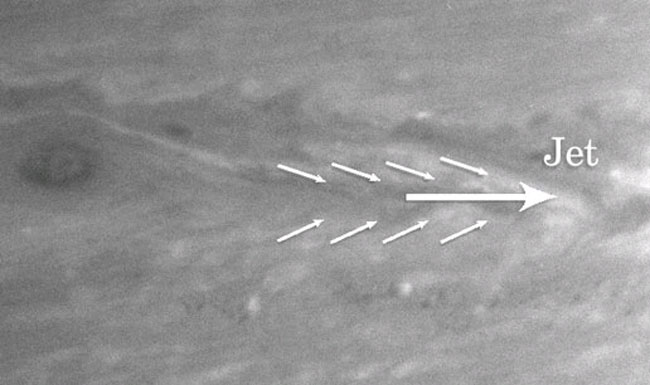Cassini Probe Spies Source of Saturn's Jet Streams

The Cassini spacecraft circling Saturn has returned images of immense rotating storms that appear to be the powerhouse behind the ringed planet's jet streams.
Saturn's giant rotating storms -- or eddies -- feed into the planet's swift jet streams, much like rotating gears can power a conveyor belt, by pumping them with energetic winds, Saturn researchers announced Tuesday.
"The new information about how Saturn's jet streams are powered is exactly the opposite of what we thought prior to Cassini," said the study's leader Anthony Del Genio, a Cassini imaging scientist at NASA's Goddard Institute for Space Studies in New York City.
Jet streams are regions in which the motions of a planet's atmosphere swiftly blow winds east or west. On Saturn, jet streams can blow 10 times faster than they do on Earth and reach speeds of up to 1,000 miles (1,609 kilometers) per hour, NASA researchers have said.
Researchers had previously thought Saturn's eddies would siphon energy from the planet's jet streams, not amplify them, due to atmospheric friction and tugging between storms.
"We knew the eddies were powering the jets because they were pointing in the same direction and carrying the same momentum in that direction," said Andrew Ingersoll, a Cassini imaging team member at the California Institute of Technology in Pasadena, California.
Similar interactions between swirling storm eddies and jet streams have been seen on Earth and, more recently, in the cloud banks of Jupiter, but the new Cassini findings are a first for Saturn. On Earth, a pair of well-known jet streams circle the planet in the northern and southern hemisphere.
Breaking space news, the latest updates on rocket launches, skywatching events and more!
Scientists used Cassini's observations to track cloud movements during successive images taken about 10 hours apart, or about one Saturn rotation, to link the planet's storm eddies and jet streams. The research is detailed in the solar system-focused science journal Icarus.
Additional images of Saturn's southern hemisphere suggest the process occurs on a planet-wide scale and explains why the ringed world's alternating bands of eastward and westward jet streams have remained constant despite decades of observations, researchers said.
- VIDEO: Saturn's Weird North Pole Hexagon
- IMAGES: Cassini's Latest Discoveries
- Special Report: Cassini's Ongoing Mission to Saturn and its Moons

Tariq is the award-winning Editor-in-Chief of Space.com and joined the team in 2001. He covers human spaceflight, as well as skywatching and entertainment. He became Space.com's Editor-in-Chief in 2019. Before joining Space.com, Tariq was a staff reporter for The Los Angeles Times covering education and city beats in La Habra, Fullerton and Huntington Beach. He's a recipient of the 2022 Harry Kolcum Award for excellence in space reporting and the 2025 Space Pioneer Award from the National Space Society. He is an Eagle Scout and Space Camp alum with journalism degrees from the USC and NYU. You can find Tariq at Space.com and as the co-host to the This Week In Space podcast on the TWiT network. To see his latest project, you can follow Tariq on Twitter @tariqjmalik.
